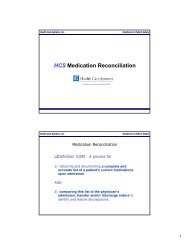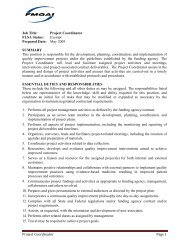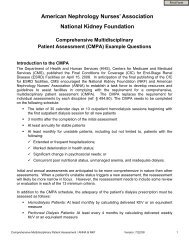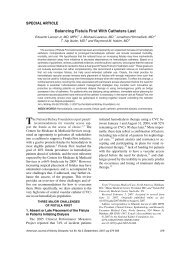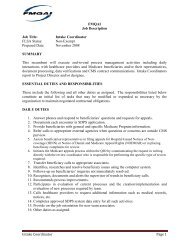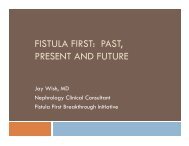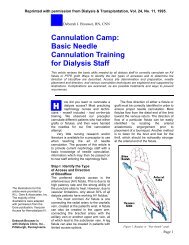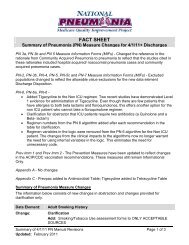The Nurse's Role in Promoting a Culture of Patient Safety - FMQAI
The Nurse's Role in Promoting a Culture of Patient Safety - FMQAI
The Nurse's Role in Promoting a Culture of Patient Safety - FMQAI
You also want an ePaper? Increase the reach of your titles
YUMPU automatically turns print PDFs into web optimized ePapers that Google loves.
<strong>of</strong> this type <strong>of</strong> voluntary report<strong>in</strong>g is to identify and respond to such events to improve the<br />
quality <strong>of</strong> care delivered (Jo<strong>in</strong>t Commission on Accreditation <strong>of</strong> Healthcare Organizations,<br />
2002). Healthcare organizations are required to respond to sent<strong>in</strong>el events and conduct root cause<br />
analysis. <strong>The</strong> JCAHO developed a framework for conduct<strong>in</strong>g root cause analysis to educate and<br />
assist healthcare organizations <strong>in</strong> analyz<strong>in</strong>g sent<strong>in</strong>el events (Jo<strong>in</strong>t Commission on Accreditation<br />
<strong>of</strong> Healthcare Organizations, 2005b). Between 1995 and 2004, there were 2,966 sent<strong>in</strong>el events<br />
reviewed and analyzed by JCAHO (Jo<strong>in</strong>t Commission on Accreditation <strong>of</strong> Healthcare<br />
Organizations, 2005d), and more than 60 percent <strong>of</strong> sent<strong>in</strong>el events reported to JCAHO<br />
identified communication as a root cause <strong>of</strong> the event (Jo<strong>in</strong>t Commission on Accreditation <strong>of</strong><br />
Healthcare Organizations, 2004).<br />
In addition to the sent<strong>in</strong>el events program, the JCAHO began requir<strong>in</strong>g compliance with<br />
its National <strong>Patient</strong> <strong>Safety</strong> Goals for organizations seek<strong>in</strong>g accreditation, thus ensur<strong>in</strong>g a greater<br />
focus on patient safety. <strong>The</strong> JCAHO has developed safety goals for ambulatory care, assisted<br />
liv<strong>in</strong>g, behavioral health, home care, hospitals, and long-term care organizations (Jo<strong>in</strong>t<br />
Commission on Accreditation <strong>of</strong> Healthcare Organizations, 2005c). <strong>The</strong>se goals are reviewed<br />
and revised each year, and apply to various accreditation programs <strong>of</strong>fered by JCAHO. Some <strong>of</strong><br />
the 2005 goals <strong>in</strong>clude:<br />
• Improve the accuracy <strong>of</strong> patient /client/resident identification<br />
• Improve the effectiveness <strong>of</strong> communication among caregivers<br />
• Reduce the risk for healthcare-associated <strong>in</strong>fections (Jo<strong>in</strong>t Commission on<br />
Accreditation <strong>of</strong> Healthcare Organizations, 2005a).<br />
<strong>The</strong> complete list <strong>of</strong> safety goals, <strong>in</strong>clud<strong>in</strong>g the new 2006 <strong>Patient</strong> <strong>Safety</strong> Goals are available at<br />
the JCAHO website (www.jcaho.org/accredited+organizations/patient+safety/npsg.htm).<br />
16





